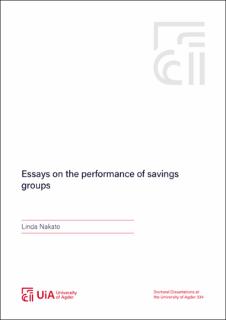| dc.description.abstract | This thesis consists of three chapters that each address a different factor that influences the performance of SGs.
Chapter 1 investigates the effect of financial linkages on the performance of savings groups. Financial linkages occur when informal savings groups either open a joint savings account at a formal financial institution or participate in a joint credit facility arrangement with a formal financial institution. The central reason for financial linkages between savings groups and formal financial institutions is to balance group liquidity shortages and excesses. Additionally, financial linkage is attractive as it is viewed as a conduit for formal financial inclusion. Applying a difference-in-differences methodology to a matched sample of data on 3,234 savings groups from 31 countries, we investigate the differential effect of a savings and credit linkage. This is complemented with a qualitative investigation from SGs in Uganda that provides more insight into the observed results obtained from the quantitative investigation. Overall, there is a positive effect of savings linkage on savings per member and return on savings. We argue that this is due to the safekeeping function that an account with a formal financial institution provides. There is, however, a reduction in the fund utilization rate following a savings linkage, probably because the cash is no longer readily at hand in the lockbox but is now deposited in a bank that may be geographically located at a distance from the group and may also require procedures to withdraw it. By contrast, there is a negative effect of the credit linkage on savings per member and return on savings. This may be because infusion of external capital discourages internal savings mobilization. The results suggest that financial linkage should be demand-driven, i.e., based on the need of the SG, and savings group facilitators should weigh the costs against the benefits before prescribing financial linkages for SGs.
Chapter 2 takes a critical look at the effectiveness of financial education delivered through the informal savings groups. There is widespread recognition that traditional classroom-based financial education has fallen short of stimulating substantial changes in adult financial behavior (e.g., Carpena, Cole, Shapiro, & Zia, 2019). We show that savings groups provide an innovative delivery channel for financial education especially at the bottom of the pyramid. Based on a matched sample of data on 2,364 savings groups from 9 African countries, our random effects regression results show the benefits of financial education both at the individual and at the group level. At the individual level, members increase their savings as evidenced by the increase in savings per member. At the group level, there is an increase in profitability and the rate at which members’ savings are converted into loans. This is evidenced by the increased fund utilization rate and return on savings for groups that receive financial education. We partly attribute this to the fact that savings groups offer members an immediate opportunity and framework for putting into practice the new financial knowledge acquired. The findings show that knowledge alone may not be enough to change individual financial behavior and should be complemented with practical hands-on experience as is possible in SGs.
Chapter 3 delves into the composition of the group in terms of gender and how this influences the group’s profit-generating capacity. I start from the premise that, like many development efforts, the savings group was initially promoted as a gender-focused financial initiative with a particular emphasis on women. The first facilitated savings group, the Village Savings and Loan Association, was at its inception exclusively composed of women. Yet, recent trends suggest that male participation and advocacy to engage men as group members are increasing. I investigate the effect of male membership on the profit-generating capacity of savings groups and further probe the moderating effect of gender equality in the countries where the groups are located. Based on a sample of 81,853 savings groups from 30 countries, random effects regression results suggest that male membership negatively impacts the profit-generating capacity of savings groups. Moreover, gender inequality in a country strengthens the observed relationship. These findings highlight the need to thoroughly appraise gender-based interventions aimed at the SGs in order to avoid harming some aspects of their core operational model. Further, they also show that contextual factors should be accounted for before rolling out interventions. | en_US |
